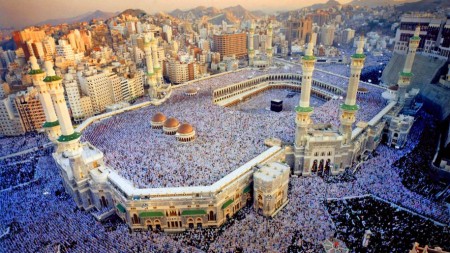HISTORICAL INFO ABOUT THE HOLY KAABA AND MASJID AL-HARAM

The very first building of the Holy Kaaba was done by Prophet Ibraheem (AS) and his son Hazrat Ismaeel (AS) as a house of worship to one ALLAH Almighty. Soon after Prophet Ibraheem (AS) died, people started filling the Holy Kaaba with idols. It was not until Prophet Muhammad (PBUH) defeated and beaten the idol-worshippers that the idols inside the Holy Kaaba were destroyed.
Among the Five Pillars of Islam requires performing the Hajj pilgrimage by every Muslim to Makkah at least once in his or her lifetime if they are physically and financially able to do so. Multiple parts or steps of the Hajj require pilgrims to walk around the Holy Kaaba seven times in a counter-clockwise direction. This circumambulation (Tawaaf), is also done by pilgrims while performing Umrah.
Muslims all around the world face the Holy Kaaba during namaz or salah, no matter where they are. This is well known as facing the Qiblah.
As mentioned in this verse 2:144 in the Holy Quran,
We have certainly seen the turning of your face, [O Muhammad], toward the heaven, and We will surely turn you to a qiblah with which you will be pleased. So turn your face toward al-Masjid al-Haram. And wherever you [believers] are, turn your faces toward it [in prayer]. Indeed, those who have been given the Scripture well know that it is the truth from their Lord. And Allah is not unaware of what they do.
Masjid Al-Haram was built around the Holy Kaaba. It is also the largest masjid or mosque in the world. The first Muslim structure on the site was a wall around the Holy Kaabah was initially built under the leadership of the Caliph (khalifa) Omar Ibn al-Khattab and has been modified incessantly under numerous Muslim rulers. Omar, the first Caliph, commanded the destruction of some houses surrounding the Holy Kaaba in order to accommodate the increasing number of pilgrims and construct a 1.5 meter high wall to define a large namaz or prayer area.
During the supremacy of his successor Caliph Uthman Ibn Affan the namaz (prayer) space was enlarged and was covered with a roof carried on wood arches and columns. In 692, after Caliph Abdul Malik bin Marwan conquered Makkah from Ibn Zubair, the guardian of the holy site, the outer walls of the masjid (mosque) were raised, the ceiling was also sheltered with teak and the column capitals were painted in gold. His son, Al-Walid contributed to the Mosque of Al-Haram (Masjid-Al-Haram) by replacing the wooden columns with marble ones and by beautifully decorating its arches with mosaics.
Afterwards, Abbasid Caliph Abu Jaafar al-Mansur added mosaics to the columns. He also doubled and enlarges the size of the northern and western wings of the namaz (prayer) hall and erected the minaret of Bab ul-Umra on the northwest corner. In 777, because of the growing number of pilgrims, Abbasid Caliph al-Mehdi ordered the rebuilding of the masjid (mosque), demolishing more houses around the Holy Kaaba. The new mosque enclosure centered on the Holy Kaaba. It was constructed on a grid plan, with marble columns from Syria and Egypt, decorated with gilt teak wood inlay. Al-Mehdi also built three minarets crowned with crenulations and placed above Bab al-Salam, Bab Ali and Bab al-Wadi of the masjid (mosque).
Cheapumrahpackage.net is one of the authorized Hajj and Umrah travel agent based in UK offers a range of Umrah Packages 2017 from UK.
